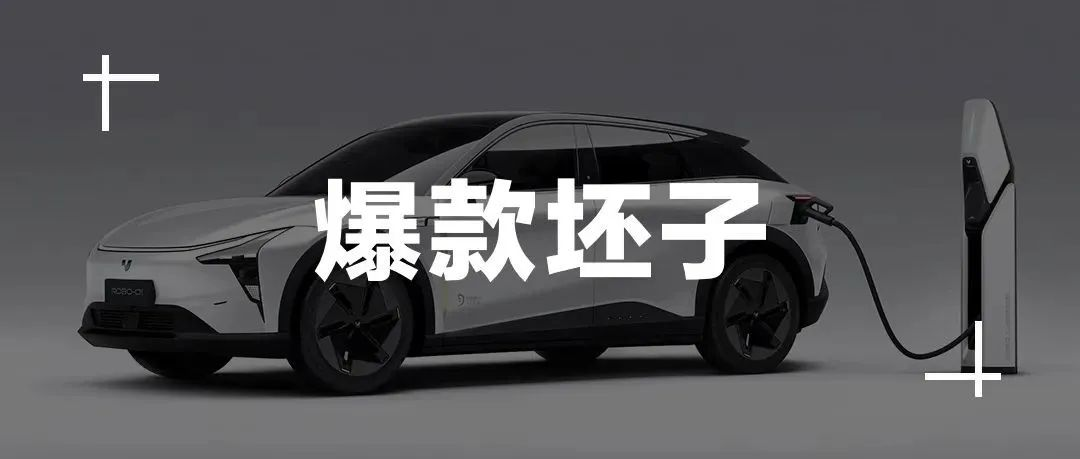ROBO-01 Lunar Edition: A New Star of the EV Market?
On October 27th, Jidu’s first car robot, ROBO-01 Lunar Edition, was officially released.
At this point in 2022, even products made by new car companies find it hard to “wow” China’s picky EV users with their product designs and intelligent expressions. Therefore, this product, which has been polished for 605 days, needs to demonstrate enough “sincerity” to establish itself in China’s competitive new energy vehicle market.
Regarding Jidu’s “sincerity,” we’ve summarized several key issues:
- Is ROBO-01 competitive compared to other similar products?
- Will there be significant differences between the Lunar Edition and the regular version of the car?
- Is this vehicle worth purchasing?
Let’s discuss these questions in detail.
A Potential Bestseller?
First of all, in terms of the product’s positioning, the ROBO-01 Lunar Edition that Jidu released this time is a special version created in collaboration with China’s lunar exploration project. The official price given is CNY 3.998 million.
You may initially think that this price is high, and it is. But you should know that this is a special edition, and it is not meant to be a mass-market product. Even from the first batch of 1000 units to the additional 1000, it is clear that this is not supposed to be a high-selling product. It is, in fact, a version designed to raise brand awareness – just like XPeng P7 Pengyi edition and NIO ES8 First Launch commemorative edition.
Furthermore, for Jidu, the most important thing is to show what the regular version of ROBO-01 is capable of. Therefore, we can use the ROBO-01 Lunar Edition to assess whether the regular version is a genuinely “good car.”
ROBO-01 is developed based on Geely’s Haohan Pure Electric Platform. The entire three-electric system is actually very similar to the current Zeekr001, and ROBO-01 is co-produced with Zeekr001, so the chassis and platform quality can refer to Zeekr001.
At present, a high-quality pure electric product must have three strengths: mechanical quality, attractive design, and strong intelligence. 27th Group officially announced the information of the first mass-produced car, let’s make a quick summary:
Vehicle Size: Solid
ROBO-01 Lunar Exploration Limited Edition (hereinafter referred to as ROBO-01) has leading vehicle parameters and space performance in the same level. It should be noted that this time the one released is the Lunar Exploration Limited Edition, the vehicle is basically fully equipped. Previously, Xia Yiping, CEO of 27th Group, also revealed that the standard version will not reduce the core hardware configuration of intelligence, and there will only be differences in motors and other areas.
ROBO-01 Lunar Exploration Edition has a body length of 4853mm, a width of 1990mm, a height of 1611mm, and a wheelbase of up to 3000mm, providing comfortable interior space while achieving dynamic posture. The luggage compartment storage space is up to 555 L, and the rear seats can be flat-folded to have 1528 L of storage space, which is already a standard mid-to-large SUV size.
Reference to the Tesla Model Y Performance Edition:
 As with other car manufacturers, Jidu’s hypothetical enemy is Tesla. However, Jidu CEO Xia Yiping has repeatedly expressed his recognition of Tesla publicly, and he has said that learning from outstanding people is also part of Jidu’s culture.
As with other car manufacturers, Jidu’s hypothetical enemy is Tesla. However, Jidu CEO Xia Yiping has repeatedly expressed his recognition of Tesla publicly, and he has said that learning from outstanding people is also part of Jidu’s culture.
Therefore, when it comes to car prices and sizes, we can see that Jidu’s ROBO-01 is basically benchmarking Tesla, but the smart thing about Jidu is that their prices are lower and their sizes are larger than their competitors.
Design is not just about good looks
The designer responsible for the design of ROBO-01 is Wu Fan. His main public titles include being an outstanding designer for the Red Dot Award and a designer for the Cadillac CT6 product.
Compared to these titles, as a designer, I believe that Wu Fan cares more about other people’s opinions on his latest work, ROBO-01.
Without further ado, here is the demonstration of his talent.
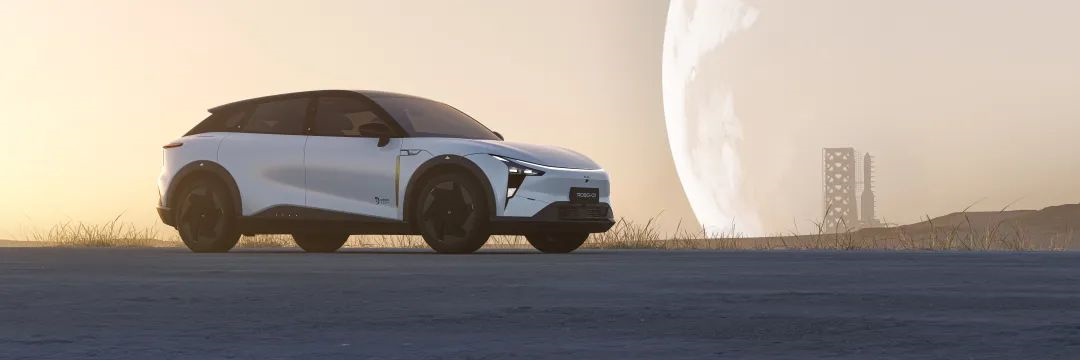


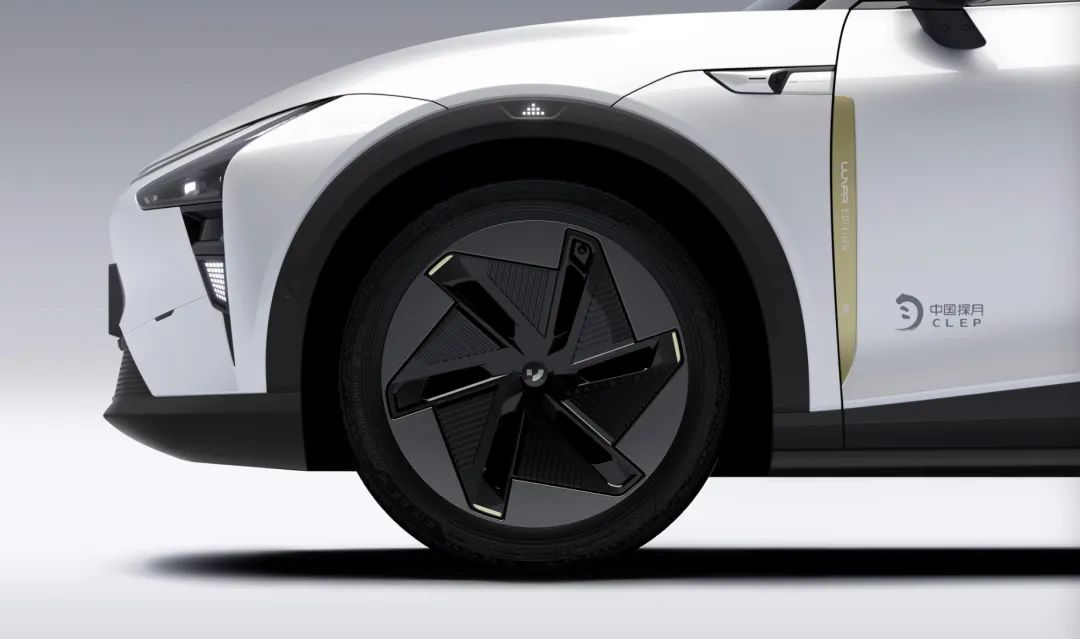

The length of the ROBO-01 lunar limited edition is only 4853 mm, while the wheelbase is 3000 mm. The 4.8-meter body length is not the largest among the new energy products with extremely compact vehicle dimensions. The goal is to increase the interior space by making the wheelbase as long as possible. Interestingly, the ROBO-01 is also nearly 2 meters wide.
There is only one explanation for doing this. The goal is not to make a “big-for-the-sake-of-being-big” car, but to use design to enhance the available space inside the car while maintaining the low-slung proportion and posture of the entire vehicle.
As a result, we can see the clean and streamlined surface relationship of the entire ROBO-01 vehicle, as well as a rare low-slung feeling on an SUV. When it comes to a car’s appearance, there is no standard answer, and there is still room for discussion when it comes to Jiudu’s design.
So, how do automobile companies use design to showcase the beauty of engineering?
Exterior Design

Although I don’t know if Xia Yiping is a fan of design master Zaha Hadid, I can always see Zaha’s surface art on the ROBO-01. You won’t see any hard lines on the ROBO-01. From the front to the back of the car, it has a very rounded feeling, but if you look closely, you’ll find that the car hasn’t lost its sportiness because of its “roundness.”
Here’s a design detail: the benefit of using “roundness” in car design is that compared to sharp creases, the rounded transition surfaces will prolong the time when the product design style becomes outdated. However, the disadvantage is obvious: it’s very easy to make the design look bloated.
Meanwhile, Jidu’s approach is to use the arc of the roofline, waistline, fold lines that run through the headlights, and rear fold lines to decorate the body posture and sense of power. For example, like other pure electric products, ROBO-01 also has a fully enclosed front face, and the integrated light strip runs through the joint of the front hood and the vertical surface of the front face.
The detail is that the width of this light strip is narrow and the density of the lamp beads is high, which can increase the overall visual integrity. The front headlight’s forward protrusion connects with the facial contour line and the upper part connects with the car’s side waistline, which creates a high overall integration.
Why do we need to explain this?

Because Jidu’s design seems to have borrowed a lot from Zaha’s design ideas in architecture. We all know that the soul of Zaha’s “deconstructive design” is to use “lines” to express the structure of architecture. However, few people know that Zaha once said that “lines are the smallest expressions of surfaces, and when magnified, lines become surfaces”.
What Zaha means is that “design should not be confined to forms, ceilings do not have to be flat, and walls do not have to be straight”.
 If you look closely at the aerial view of Beijing Daxing International Airport, you’ll see that it uses a similar design approach as that of ROBO-01. For example, the front of the car features robust and angular shapes composed of geometric patterns, while the rear wheel well has a softer, fuller design. The suspended rear spoiler is also a beautiful example of structural architecture.
If you look closely at the aerial view of Beijing Daxing International Airport, you’ll see that it uses a similar design approach as that of ROBO-01. For example, the front of the car features robust and angular shapes composed of geometric patterns, while the rear wheel well has a softer, fuller design. The suspended rear spoiler is also a beautiful example of structural architecture.
This design language brings a sense of technology, simplicity, and purity – a concrete expression of beauty that is similar to the work of Zaha Hadid, which lacks straightforward corners, but embodies the beauty of architectural lines and futuristic technology in each of her works.
This is the visual theme that Xia Yiping established for ROBO-01, and the remaining challenge for the design and engineering team was to combine aesthetics and engineering in the development process.
While conventional designs may not be challenging for a professional automotive design and development team, the following design aspects were particularly difficult to get right.
Door Handle Design
The door handleless design is not a new concept, but it is difficult to execute well. The electric door’s opening damping angle and speed pose high demands on the engineering development team, such as limiting the lever and software algorithms. So how do you overcome these challenges?
Here are some of the features of the ROBO-01 door design:
- Four electric doors with no mechanical handles for entry and an electric suction feature;
- Six ways to open the doors, including UWB keys, Bluetooth, NFC, voice, large-screen touch, and physical buttons.- 8 closed door modes including UWB key, Bluetooth, NFC, voice control, large screen, physical button, automatic closing when gear shift or accelerating, and central locking.
To achieve a seamless experience for users when entering and exiting the car, JiDu has implemented the following:
- JiDu has optimized the limiters and software algorithms of the electric doors to reduce the resistance when opening or closing the doors, providing a natural and user-friendly experience similar to that of manual doors.
- JiDu has installed a millimeter-wave radar inside the car doors to accurately detect obstacles outside the car. With self-developed algorithms, JiDu can precisely control the opening and closing angle and speed of the doors.
- As for voice control, JiDu believes that technology should be the first choice if it can solve manual door opening methods. Users can open the car doors by voice commands outside the car, and JiDu claims to have the ability to accurately recognize multiple sound zones. In addition, JiDu also provides digital keys (UWB, Bluetooth) and physical buttons on the B and C pillars, providing multiple options for opening car doors.
Pixelated interactive headlights and sliding charging ports

The ROBO-01 is equipped with interactive AI pixelated headlights and a high-recognition AI voice interaction system, allowing users to customize vehicle patterns and interact with the environment, such as displaying charging speed during charging. JiDu has improved the traditional induction-based charging port by adding touch buttons and a vehicle screen switch. The most special feature is the voice command switch.
This voice command feature isn’t limited to the driver inside the car. JiDu has positioned sensors around the car to pick up external sounds and use algorithms to filter out noise and locate the sound source. This allows for voice commands from both inside and outside the car.
Active up-down rear wing
On the ROBO-01 Lunar Edition, the rear of the car is equipped with an active lift tail wing that can be opened and closed manually or automatically. It can adaptively adjust according to different driving conditions.
- From a design perspective, the overall appearance of the car is more sporty.
- In terms of functionality, when driving at high speeds, the car automatically lifts the active tail wing to enhance downforce. When the speed decreases, the tail wing automatically retracts.
- In terms of driving safety, the dirty airflow from the roof during high-speed driving is combed by the tail wing to release clean airflow, enhancing driving stability.
Exclusive design for Lunar Edition
The limited edition ROBO-01 Lunar Edition uses star porcelain white as the exclusive body color, with a golden paint spray exclusive to lunar probes, and is decorated with a “LUNAR EDITION” logo and clear-coated.
The “Chinese Lunar Probe” LOGO sign is prominently displayed at the door. In addition, the ROBO-01 Lunar Edition has added golden elements to the 21-inch aerodynamic wheel rims.
Interior design

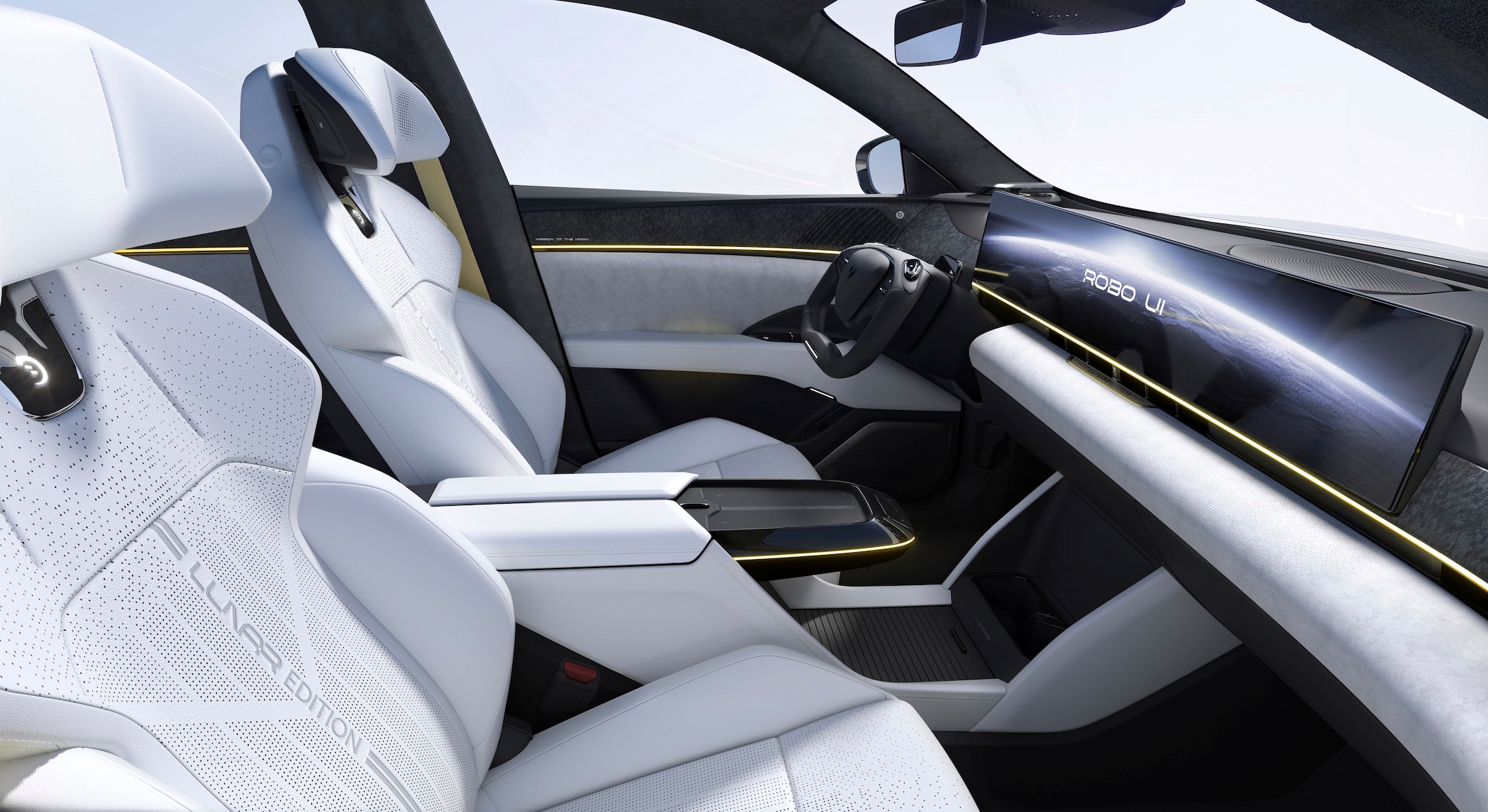
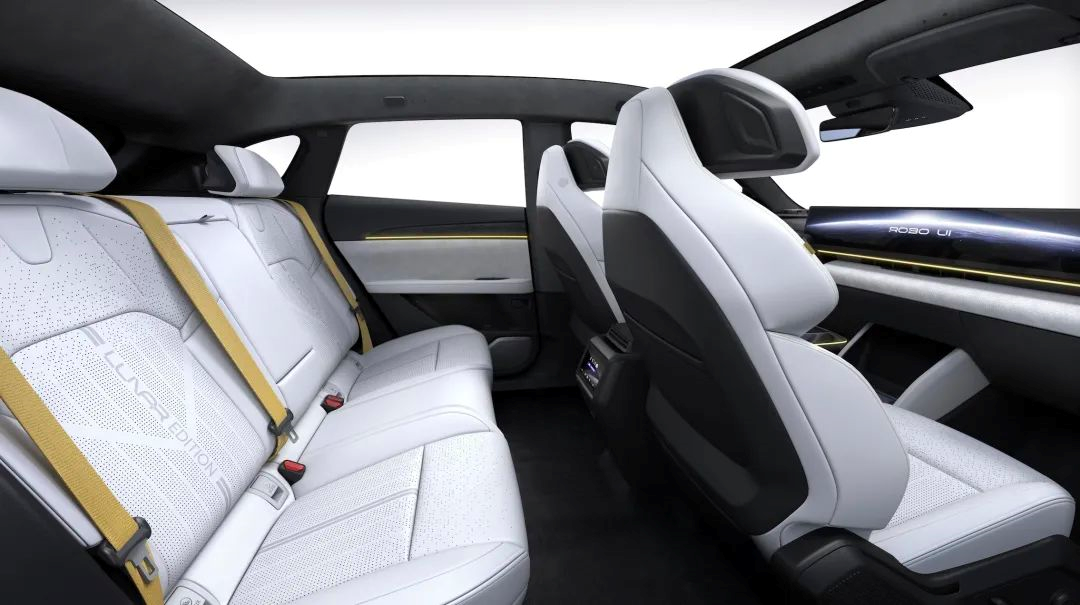 Here is the English Markdown text with HTML tags preserved:
Here is the English Markdown text with HTML tags preserved:
In summary, this is the most “shocking” interior of a pure electric SUV I have seen in 2022.
First of all, shocking does not necessarily mean good looking. As for the design itself, each user should have and should make their own judgment.
The main reasons for being “shocking” are:
One, the huge ultra-clear screen.

Officially, the display screen of this vehicle is called “3D borderless integrated ultra-clear screen”.
This has two meanings. One is the physical size. ROBO-01 is equipped with a 35.6-inch 6K ultra-clear one-piece screen, which is not split, blocked or spliced, and is consistent throughout the series, regardless of whether it is the standard or the lunar rover version.
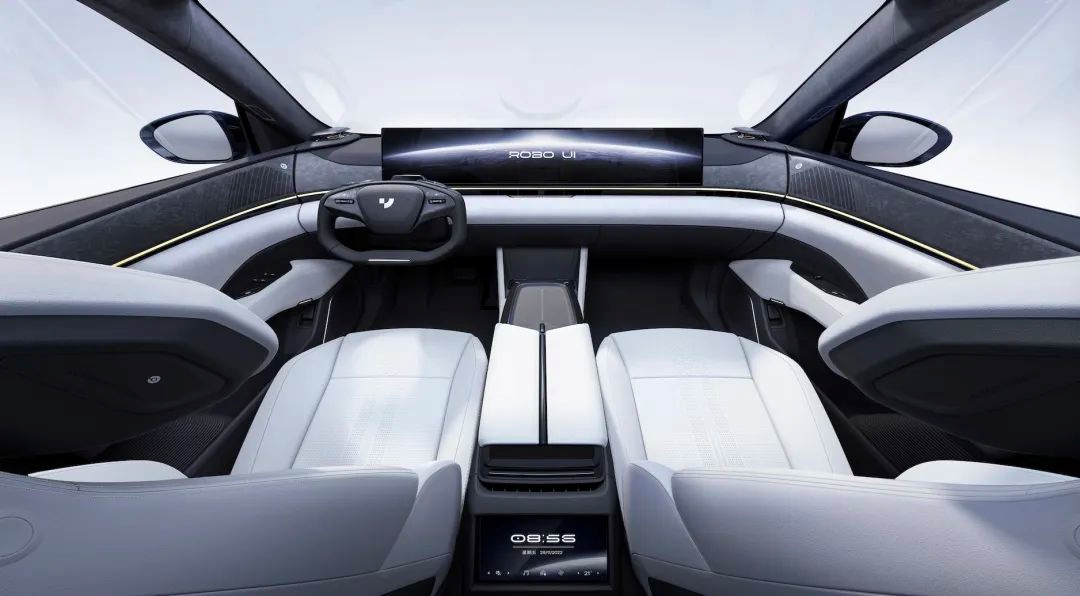
Take a look at some of the specifications:
- 6K resolution
- LED local dimming technology
- 95% NTSC color gamut
- 10,000:1 ultra-high contrast ratio
Such precise parameters are usually only seen at phone or Apple computer events. One intuitive feeling is that it is three times wider than Tesla Model Y’s screen, and its seamless screen integration is stronger than LI ONE, and there is also a 7-inch rear function screen in the back row.
Two, the least physical buttons.
New car brands are keen to eliminate physical buttons, which is usually seen as a cost-cutting measure. This is one reason, but clearly not the main one. They want to change the traditional way of human-car interaction. Tesla’s next-generation design basically eliminates all the physical buttons in the car.集度可能会是国内首个这样做的企业。它消除了很多物理操作,例如换挡可以在屏幕上进行,并在中控板的角落设有物理按钮作为替代。U型方向盘是第一个量产的国内汽车方向盘,这款车以后的所有版本都将配备 U 型方向盘,不再遮挡前排屏幕,使驾驶员能够自由完整地获取屏幕信息。 这款方向盘通过电动调节、配备智能表面和智驾指示灯来提供轻便、精确、舒适的转向体验,并且具有集成的转向灯机构、雨刮等功能。 该公司的核心理念是:不要为了创新而创新,一切创新都应该服务于真实的用户体验,希望车是载体,是高度自动化的工具。 AI是驱动核心,因此有很多前置设计,例如语音可以车内车外,语音可以开关车门等等。集度的理念是追求产品的设计理念和与功能的完美结合,而某些新造车企业的智驾负责人告诉我:”新车公司如果没有智能化能力,造电动车还不如回家躺平。” 因此,为了保持竞争优势,集度致力于智能化,例如智能座舱等。
In terms of intelligent cabin, Jidu will first be equipped with Qualcomm Snapdragon 8295 chip. Based on the powerful computing platform like 8295, Jidu can provide immersive 3D visual HMI and entertainment experience.
Jidu has created a 3D intelligent driving map, which uses graphical representations to express lane-level navigation and realizes the fusion of static map navigation and dynamic perception data, so that the vehicle’s perception is running on a three-dimensional map. Compared with Tesla or Ideal Auto’s perceptual visualization rendering, Jidu’s is the real-life scenery rendered in real time using 8295, with not only precision but also rich display.
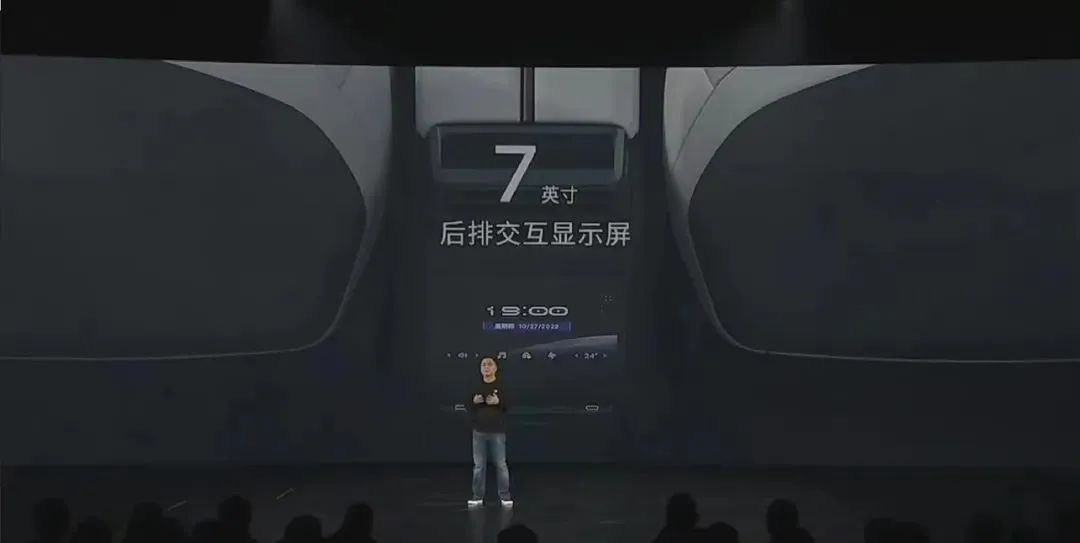
Not only visible in Jidu’s car, but also necessary for usage. A set of car machines should have reasonable interaction in addition to simple visual effects. Jidu’s voice interaction uses three capabilities:
-
Thanks to the powerful computing power of Qualcomm 8295, Jidu is the first in the industry to achieve full localization of AI voice algorithm. ROBO-01’s full-domain, fully offline voice realizes end-to-end recognition capabilities.
-
The end-to-end voice recognition speed is as fast as 500 ms, and the end-to-end interaction response speed is within 700 ms; It completely eliminates the dependence on network signals, and can smoothly interact even in weak or disconnected network scenes such as tunnels, underground garages, and mountainous areas.
-
It supports parallel recognition of multiple users, super long-time full-duplex interaction, covering all high-frequency scenes in the vehicle and enabling voice interaction between people and vehicles outside the vehicle.Simply put, after implementing the multi-tone zone and continuous speech function for the front and rear rows, ROBO-01 further realized multi-person parallel speech ability, for example, two or three people in the car could wake up commands simultaneously, even if each command was different, the system would execute them all based on the fastest command picked up. In addition, relying on Baidu’s speech engine, the voice capability has been localized, which means users can use voice anytime, anywhere.
Autonomous driving advantage of Jidu
Jidu aims to achieve the safest point-to-point navigation assistance, that is, Point to Point Autopilot (PPA).

First, let’s look at the hardware architecture:
- 2 NVIDIA Orin X chips (508 TOPS)
- 2 LiDARs (covering 180° FOV in front)
- 5 millimeter-wave radars
- 12 ultrasonic radars
- 1 driver infrared perception camera
- 2 high-precision positioning units (dual-frequency GNSS + IMU)
- 12 autonomous driving high-definition cameras (7 with 8 million pixels, 4 with 3 million pixels, and 1 with 2 million pixels)
This hardware can be considered one of the strongest on the market, and Xia Yiping emphasized that whether it is ROBO-01 or other models in the future, each generation of products will be equipped with the current hardware capabilities. However, for autonomous driving systems, hardware is only the foundation, and software is the key to whether it’s easy to use or not.
The combination of “Baidu Apollo + Jidu” with L4 companies and new forces in car making has a unique advantage in promoting the mass production of autonomous driving systems. This advantage lies in the high degree of consistency in mass production efficiency, function iteration speed, and user experience.
The following players in China are relatively advanced in promoting mass production of autonomous driving vehicles:
- WeRide
- Huawei + HiPhi
- Huawei + Avita’s HI Plan
- Momenta + IM
- Great Wall + WOZLORT, etc.
WeRide and these enterprises advocate full-stack research and development from scratch. They themselves do not have the L4 gene and Robotaxi fleet, which means that they need to do a lot of basic construction work in the early stages, including data collection, processing, etc. Moreover, the low selection rate for autonomous driving in the early stages also makes it difficult for them to obtain data, so the autonomous driving functions need to be iterated step by step and gradually opened. They also need to find third-party suppliers for high-precision maps.
It was not very easy for Huawei’s ADS program to take off. Although Huawei has strong technology in autonomous driving algorithms and hardware, the progress in promoting mass production has been slow. The main reason is that the difficulty in collecting high-precision maps and engineering algorithms is too high. Similarly, Huawei does not have its own Robotaxi fleet, so they have no way to test their own solutions on the road. This also leads to low iteration efficiency of the entire system.
The advantage of Baidu + Jidu lies in the fact that Baidu Apollo has accumulated profound experience in the field of L4 autonomous driving in the past 10 years. Moreover, it has extended its research in robotaxi, emphasizing on laser radar as the main sensor and Apollo Lite mass production solutions with visual technology as the main component.
Over the years, the road test data accumulated by Baidu has been continuously circulated among the technical systems of Robotaxi and Apollo Lite, promoting the iterative development of algorithms. Baidu is also a map provider, offering its own high-precision map service.Based on this foundation, Jidu Auto was established as a company standing on the shoulders of giants. As a carmaker, Jidu no longer needs to develop autonomous driving algorithms from scratch, deploy large-scale testing fleets, or redraw high-precision maps.
Most importantly, with Li Yanhong as a central leader, Jidu can coordinate the resources of Jidu, Baidu Maps, Apollo, and other Baidu intelligent platforms for mutual assistance, creating a fundamental difference compared to other companies. The prioritization and coordination of resources cannot be compared.
The core of Jidu is:
” Carrying all cutting-edge technologies from Baidu Apollo, powerful AI capabilities, and independently developing the electrical and electronic architecture, an outstanding vehicle platform, and a series of high-performance, mass-producible autonomous driving hardware while achieving an ultimate user experience.“
Of course, Jidu does not merely rely on Baidu’s Apollo solution. Jidu also has its own autonomous driving R&D team. Jidu CEO Xia Yiping told me that Jidu’s products are entirely made by Jidu’s team, including advanced intelligent driving. The architecture definition and functional strategy are all defined based on the characteristics of passenger cars.
It can be said that Baidu provided Jidu’s team with the best ingredients, but the chef is still Jidu themselves.
Jidu’s most eye-catching Baidu ASD suite on the car is known to have high-speed and urban road navigation assisted driving and automatic parking capabilities. This fully automated driving experience integrates driving domains and parking domains.
To achieve this fully automated driving experience,
Jidu introduced two Hesai AT128 semi-solid-state lidars on the autonomous driving sensors. At a previous Jidu Auto media communication meeting, Wang Weibao, head of Jidu Intelligent Driving, explained the safety advantages of using two lidars:
- The point cloud field of view is wider and safer. Compared with a single lidar design with a 120-degree FOV, the front double lidar can achieve a horizontal 180-degree FOV coverage, which has stronger recognition capabilities for pedestrians or obstacles crossing from the sides, such as “ghosting” and obstructions on the left and right sides.- The identification of key areas of the vehicle is more precise. Within the 60-degree FOV in front of the vehicle, the dual LiDAR can achieve double overlap, resulting in more point cloud data on the target object and higher recognition accuracy.
- In terms of redundant safety for advanced autonomous driving, the dual LiDAR can serve as safety redundancy for each other and has stronger reliability than a single LiDAR solution.
Currently, these two LiDAR sensors have been integrated into the SIMUCar 2.0 autonomous driving system by JD and merged with JET 1.0, which is JD’s self-developed high-level autonomous driving intelligent architecture (including electronic and electrical architecture and the whole vehicle operating system SOA).
JET intelligent architecture for car robots is designed for advanced autonomous driving.
In JD’s JET architecture, the robot’s body is the whole vehicle design and hardware, the middle layer is the robot’s nervous system, which includes the electronic and electrical architecture and the vehicle operating system for advanced autonomous driving, and the top layer is the brain, which includes the intelligent driving system and intelligent cockpit system.
Of course, the LiDAR solution is not the only core of JD’s autonomous driving.
In the SIMUCar 2.0 stage, there are two sets of autonomous driving solutions onboard, “Vision + LiDAR,” which are independent dual systems. Compared with traditional solutions, JD’s two sets of autonomous driving solutions are mutually dependent and complement each other, with the ability to drive efficiently and coordinate efficiently.
Mobileye also had similar solutions before. Essentially, JD’s solution is a perception-based architecture that adds LiDAR to compensate for the shortcomings of the camera in perception.
Xia Yiping said that in the long term, JD will gradually switch to a solution that relies more on perception and less on maps, but this requires progress in systems engineering, including algorithms and data, to provide sufficient information depth for perception.
At the SIMUCar 2.0 stage, JD’s related domain controllers and sensors have gradually reached mass production status, and some basic autonomous driving abilities, including ADAS functions, parking, and intelligent interaction, will gradually reach mass production status.In general, based on the known information, JD.com’s ROBO-01 is highly competitive in the industry.
- In terms of hardware, even in Q3 of 2023, it will still be one of the highest versions in the intelligent driving field;
- In terms of software, JD.com has nine years of deep cultivation in Apollo intelligent driving, with incomparable advantages in perception algorithm and rule control compared to WeRide;
- In terms of generalization, JD.com has Baidu’s high-precision maps and Apollo’s 36 million kilometers of actual road tests. In a short time, JD.com can obtain the richest scenarios to train algorithms to achieve the fastest scene generalization.
Conclusion
Now we can answer the title question: “Is JD.com’s ROBO-01 a good car?”
The answer depends on several aspects:
First, if the regular version only cuts on the motor and similar comfort configurations, and the entire intelligent driving system and car intelligence capabilities remain unchanged, with a price drop to below RMB 300,000, even down to the RMB 270,000 price range, the cost-effectiveness of this car will be incomparable.
Second, JD.com’s car and intelligent driving systems are still in the engineering version. It will take approximately another six months for the vehicle delivery next year. JD.com’s intelligent driving team has about 400 people, combined with Apollo’s support for JD.com. The challenge of industrializing and mass production of these systems in such a short period is enormous.
If JD.com can deliver cars that are ready to use as Xia Yiping said, then my answer to the question above is “yes.”
One more detail to note, Xia Yiping said that the tuning style of this car will be more sporty, harder than the current extreme ke-001, and softer than Tesla. JD.com’s goal is to be both sporty and comfortable.
This article is a translation by ChatGPT of a Chinese report from 42HOW. If you have any questions about it, please email bd@42how.com.
